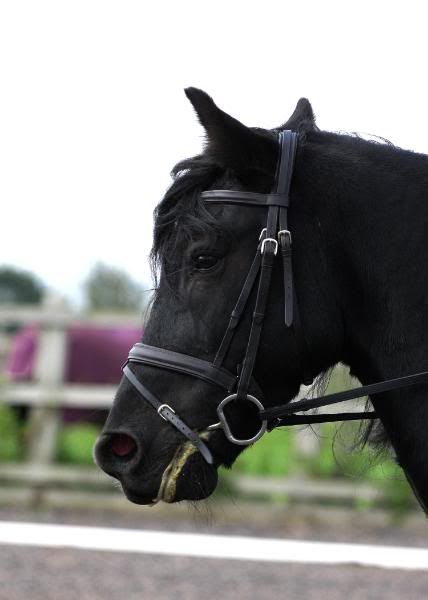Post by bellajack on Apr 5, 2007 0:11:39 GMT -1
The Royal Veterinary College Laminitis Conference Part 6.
The Role of the Farrier
The speaker for this section was:
Simon J Curtis FWCF.
He has been shoeing horses in Newmarket for 35 years and is attached to Rossdales Equine Hospital at the Corrective Farriery Department. He was a Master of the worshipful Company of Farriers (2001-2002) and is a Fellow. He is Chairman of the Farriers Registration Council and an Honorary Associate of the RCVS. He has given workshops and lectured in 17 countries on 4 continents.
His one and only broodmare also suffered from and ultimately was put down due to laminitis.
THE ONSET OF LAMINITIS.
As soon as laminitis occurs the horse must be totally confined to the stable on a 40cm deep bed of clean white woodshavings, for a minimum of 30 days.
Frog support is essential: this can be achieved using dental impression material or similar, or Styro-foam pads.
TRIMMING FOR TYPICAL FOUNDERED HORSES;
In his experience trimming alone without shoeing is ineffective as a treatment in acute or recently acute cases.
Trimming alone is only advised for foundered horses which have stabilised i.e. the pedal bone has stopped rotating or sinking.
Most foundered horses (horses with pedal bone rotation) will show clear external visual signs of laminitic changes to the hoof.
SHOEING THE ACUTE OR RECENTLY CHRONIC FOUNDERED HORSE.
The heart bar shoe with dorsal wall resection has proven successful in many cases, but requires x-rays.
Reshoeing is strictly at one month intervals.
When the resection has almost grown out, shoeing is changed to a conventional shoe with rocker toe.
Small pockets of seedy toe often remain.
ALTERNATIVES:
Coronary band grooving instead of full dorsal wall resection - not something he does.
The Equine Digital Support System (EDSS): A Natural Balance shoe set radically back and the hoof filled with a frog support pad and dental impression material, and additional wedges are fitted in response to horse's level of comfort.
The glued rail shoe. Similar to above but attached with acrylic.
THE CHRONIC FOUNDERED HORSE: 3 months plus:
Ponies and small horses survive better than other breeds.
The characteristic changes seen are diverging growth rings at heels, a flared,concave, dorsal hoof wall, and a distended white line at the toe.
The hoof should be trimmed to return it to normal dimensions.
We were also shown some very graphic colour images of what is happening inside the hoof of a sinker or long term chronic founder horse - the pedal bone being eroded away by rubbing against the sole, with dead bone flaking off, causing abscesses and large pieces of bone breaking away often necessitating the destruction of the horse. The pain these horses must have been in must have been indescribable.
The Role of the Farrier
The speaker for this section was:
Simon J Curtis FWCF.
He has been shoeing horses in Newmarket for 35 years and is attached to Rossdales Equine Hospital at the Corrective Farriery Department. He was a Master of the worshipful Company of Farriers (2001-2002) and is a Fellow. He is Chairman of the Farriers Registration Council and an Honorary Associate of the RCVS. He has given workshops and lectured in 17 countries on 4 continents.
His one and only broodmare also suffered from and ultimately was put down due to laminitis.
THE ONSET OF LAMINITIS.
As soon as laminitis occurs the horse must be totally confined to the stable on a 40cm deep bed of clean white woodshavings, for a minimum of 30 days.
Frog support is essential: this can be achieved using dental impression material or similar, or Styro-foam pads.
TRIMMING FOR TYPICAL FOUNDERED HORSES;
In his experience trimming alone without shoeing is ineffective as a treatment in acute or recently acute cases.
Trimming alone is only advised for foundered horses which have stabilised i.e. the pedal bone has stopped rotating or sinking.
Most foundered horses (horses with pedal bone rotation) will show clear external visual signs of laminitic changes to the hoof.
SHOEING THE ACUTE OR RECENTLY CHRONIC FOUNDERED HORSE.
The heart bar shoe with dorsal wall resection has proven successful in many cases, but requires x-rays.
Reshoeing is strictly at one month intervals.
When the resection has almost grown out, shoeing is changed to a conventional shoe with rocker toe.
Small pockets of seedy toe often remain.
ALTERNATIVES:
Coronary band grooving instead of full dorsal wall resection - not something he does.
The Equine Digital Support System (EDSS): A Natural Balance shoe set radically back and the hoof filled with a frog support pad and dental impression material, and additional wedges are fitted in response to horse's level of comfort.
The glued rail shoe. Similar to above but attached with acrylic.
THE CHRONIC FOUNDERED HORSE: 3 months plus:
Ponies and small horses survive better than other breeds.
The characteristic changes seen are diverging growth rings at heels, a flared,concave, dorsal hoof wall, and a distended white line at the toe.
The hoof should be trimmed to return it to normal dimensions.
We were also shown some very graphic colour images of what is happening inside the hoof of a sinker or long term chronic founder horse - the pedal bone being eroded away by rubbing against the sole, with dead bone flaking off, causing abscesses and large pieces of bone breaking away often necessitating the destruction of the horse. The pain these horses must have been in must have been indescribable.





